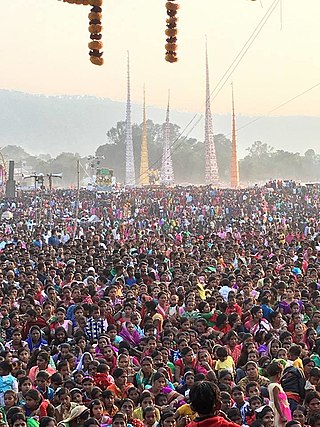Kharsawan garh is a town and a notified area in the Seraikela Sadar subdivision of the Seraikela Kharsawan district in the Indian state of Jharkhand.
Saraikela is the district headquarters and a nagar panchayat in the Seraikela Sadar subdivision of the Seraikela Kharsawan district in the Indian state of Jharkhand. It was formerly the capital of Saraikela State, a princely state. The town is a road junction, an agricultural trade centre and upcoming industrial centre. It is situated between Jamshedpur and Chaibasa.
Chandil is a census town in the Chandil CD block in the Chandil subdivision of Seraikela Kharsawan district in the state of Jharkhand, India.
Kandra is a census town in the Adityapur CD block in the Seraikela Sadar subdivision of the Saraikela Kharsawan district in the Indian state of Jharkhand.

Ichagarh is a village in the Ichagarh CD block in the Chandil subdivision of the Seraikela Kharsawan district in the Indian state of Jharkhand.
Kuchai block is a CD block that forms an administrative division in the Seraikela Sadar subdivision of Seraikela Kharsawan district, in the Indian state of Jharkhand.
Kharsawan block is a CD block that forms an administrative division in the Seraikela Sadar subdivision of Seraikela Kharsawan district, in the Indian state of Jharkhand.

Chandil block is a CD block that forms an administrative division in the Chandil subdivision of Seraikela Kharsawan district, in the Indian state of Jharkhand.
Ichagarh block is a CD block that forms an administrative division in the Chandil subdivision of Seraikela Kharsawan district, in the Indian state of Jharkhand.
Nimdih block is a CD block that forms an administrative division in the Chandil subdivision of Seraikela Kharsawan district, in the Indian state of Jharkhand.
Adityapur block is a CD block that forms an administrative division in the Seraikela Sadar subdivision of Seraikela Kharsawan district, in the Indian state of Jharkhand.

Seraikela block is a CD block that forms an administrative division in the Seraikela Sadar subdivision of Seraikela Kharsawan district, in the Indian state of Jharkhand.

Gobindpur block is a CD block that forms an administrative division in the Seraikela Sadar subdivision of Seraikela Kharsawan district, in the Indian state of Jharkhand.
Kuchai is a village in the Kuchai CD block in the Seraikela Sadar subdivision of the Seraikela Kharsawan district in the Indian state of Jharkhand.
Rajnagar is a village in the Gobindpur CD block in the Seraikela Sadar subdivision of the Seraikela Kharsawan district in the Indian state of Jharkhand.
Kukru is a village in the Kukru CD block in the Chandil subdivision of the Seraikela Kharsawan district in the Indian state of Jharkhand.
Nimdih is a village in the Nimdih CD block in the Chandil subdivision of the Seraikela Kharsawan district in the Indian state of Jharkhand.
Chowka is a village in the Chandil CD block in the Chandil subdivision of the Seraikela Kharsawan district in the Indian state of Jharkhand.
Seraikela Sadar subdivision is an administrative subdivision of the Seraikela Kharsawan district in the Kolhan division in the state of Jharkhand, India.
Chandil subdivision is an administrative subdivision of the Seraikela Kharsawan district in the Kolhan division in the state of Jharkhand, India.





